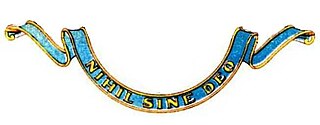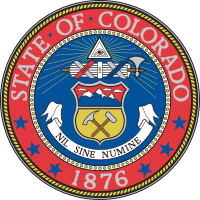Fasces is a bound bundle of wooden rods, sometimes including an axe with its blade emerging. The fasces is an Italian symbol that had its origin in the Etruscan civilization and was passed on to ancient Rome, where it symbolized a Roman king's power to punish his subjects, and later, a magistrate's power and jurisdiction. The axe, originally associated with the labrys, the double-bitted axe originally from Crete, is one of the oldest symbols of Greek civilization.

A motto is a sentence or phrase expressing a belief or purpose, or the general motivation or intention of an individual, family, social group, or organisation. Mottos are usually found predominantly in written form, and may stem from long traditions of social foundations, or from significant events, such as a civil war or a revolution. One's motto may be in any language, but Latin has been widely used, especially in the Western world.

The coat of arms of the state of New York was formally adopted in 1778, and appears as a component of the state's flag and seal.

Annuit cœptis is one of two mottos on the reverse side of the Great Seal of the United States. The literal translation is "[He] favors [our] undertakings", from Latin annuo, and coeptum. Because of its context as a caption above the Eye of Providence, the standard translations are "Providence favors our undertakings" and "Providence has favored our undertakings".

The flag of Colorado was officially adopted to represent the U.S. state of Colorado on June 5, 1911. The flag, designed by Andrew Carlisle Carson, consists of a fess design of three horizontal stripes of equal width, with the top and bottom stripes colored blue, and the middle stripe colored white. A circular red "C", filled with a golden disk, sits atop the stripes. All aspects of the flag contain symbolism related to the state, as the blue is meant to represent the sky, the gold the abundant sunshine the state receives, the white the snowcapped Rocky Mountains, and the red the "ruddy" earth. The gold and white portions of the flag also represent the state's gold and silver mining industries, respectively.

The Great Seal of the State of Hawaii was designated officially by Act 272 of the 1959 Territorial Legislature and is based on the territorial seal. Modifications to the territorial seal included the use of the words "State of Hawaii" at the top and "1959" within the circle. Provisions for a seal for the state of Hawaii were enacted by the Territorial Legislature and approved by Governor William F. Quinn on June 8, 1959. The passage of the Admission Act in 1959, admitted Hawaii as the 50th State of the United States of America on August 21, 1959.

The Great Seal of the State of Maryland is the official government emblem of the U.S. state of Maryland. Its official service is to authenticate acts by the General Assembly of Maryland, but it is also used for display purposes at most state buildings. Although the state seal has been changed in design several times throughout history, the current model represents the reverse side of the original seal.

William Gilpin was a 19th-century US explorer, politician, land speculator, and futurist writer about the American West. He served as military officer in the United States Army during several wars, accompanied John C. Frémont on his second expedition through the West, and was instrumental in the formation of the government of the Oregon Territory. As a politician and writer, he was an inveterate believer in Manifest Destiny and was a visionary booster of new settlement to the West, helping lay the groundwork in his writings for a modern theory of the succession of civilizations.

The Seal of the State of Oregon is the official seal of the U.S. state of Oregon. It was designed by Harvey Gordon in 1857, two years before Oregon was admitted to the Union. The seal was preceded by the Salmon Seal of the Provisional Government and the Seal of the Oregon Territory. The state seal is mandated by Article VI of the Oregon Constitution.

With God, all things are possible is the motto of the U.S. state of Ohio. Quoted from the Gospel of Matthew, verse 19:26, it is the only state motto taken directly from the Bible. It is defined in section 5.06 of the Ohio Revised Code and sometimes appears beneath the Seal of Ohio. The motto was adopted in 1959 and survived a federal constitutional challenge in 2001. The state maintains that it is a generic expression of optimism rather than an endorsement of a particular religion.

Nihil sine Deo, Latin for "Nothing without God", is used as a motto of the German Hohenzollern-Sigmaringen royal family and was the motto of both the former Principality of Romania and the former Kingdom of Romania.

This is an alphabetical list of articles related to the U.S. State of Colorado.

National symbols of France are emblems of the French Republic and French people, and they are the cornerstone of the nation's republican tradition.

Thomas Bartholomew Weld (1750–1810), known as Thomas Weld of Lulworth Castle, was a member of the English Catholic gentry, landowner, philanthropist and bibliophile. He was connected to many of the leading Catholic families of the land, such as the Bodenhams, Cliffords, Erringtons, Petres and Stourtons. He proved to be a great benefactor of the Society of Jesus in England in their educational and pastoral endeavours, as timely donor of his Stonyhurst estate in 1794. He was also a benefactor to other Roman Catholic religious and clergy. He was a personal friend of King George III. His sister-in-law was Maria Fitzherbert. After the French Revolution he hosted refugee remnants of the French royal family at his castle. He was the builder, in 1786, of the first Roman Catholic place of worship in England after the Protestant Reformation.














